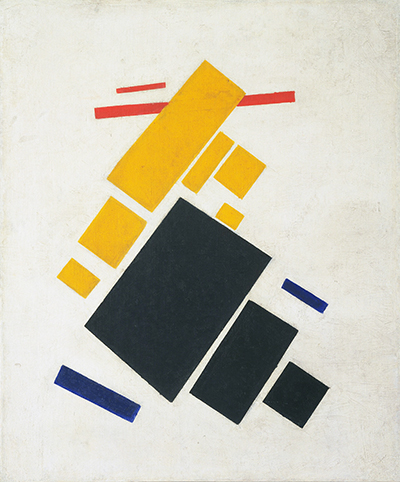Suprematist Composition: Airplane Flying was completed by Kazimir Malevich in 1915 and the artwork is entirely in keeping with his Suprematist series throughout this period of his career. Simple lines and squares would form truly abstract interpretations.
Malevich started to use flat displays of squares and lines as a means to taking the viewer away from standard logic into a world where their emotions could run freely. This was a groundbreaking approach which moved his career on from the busier look of the Futurist forms that he had been working in previously. He proclaimed that these shapes would now have supremacy over what had gone before, hence the name of the style as he called it. He regularly switched styles during his career though never left the modern umbrella once he had first joined it, merely finding alternative ways to challenge the traditional norms which he had himself been taught in his early years. The use of white backgrounds was also an important method with which to produce a feeling of the infinite, with no boundaries as are inevitable with depictions of anything from reality. It was all about expression and a purity of emotion, both for the artist himself but also the viewer.
Many would reject this style of art, even today, as without merit but in most cases those who follow the path to this point and understand better the reasons for it, will inevitably appreciate it more. Joan Miro and Piet Mondrian would create their own visual languages in which flat forms were repeated in different variants across a number of paintings and both arrived at this point later in their careers, as if they had all been on a journey themselves and could finally leave behind the more traditional art approaches which they respected but wanted to push on from within their own work. Malevich found more favour abroad than within his native Russia which started to reject his modernist values towards the end of his career, whilst the items he had left behind from an exhibition in Germany helped to build his reputation, even in his absence.
This painting can now be found in the collection of the The Museum of Modern Art in New York, USA. It remains one of the most significant art galleries in the world and its collection is extraordinary, both in terms of size but also quality. Malevich is, naturally, a very welcome addition to this institution because of the impact that he made in the first half of the 20th century even though he faced so many challenges within his lifetime. MoMA holds over 50 artworks from his career in total and affords him a great prominence within the permanent display, reflecting the critical nature of his own contributions. He can be found here alongside other highly notable abstract and modern artists, will all of the major names from the US and Europe featured, including the likes of Marc Chagall (I and the Village), René Magritte (The Empire of Lights), Piet Mondrian (Broadway Boogie-Woogie) and also Henri Rousseau (The Dream), to name just a few.




